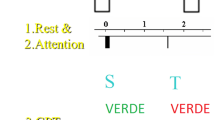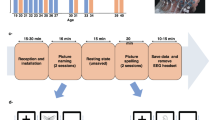Abstract
Event-related potentials were recorded during a delayed matching-to-sample design from 17 volunteers (5 f) using high-resolution (65 channels) EEG-recordings. In the two-stimulus paradigm, the 500-ms stimulus S1 comprised a visual pattern of two diamonds differing in size, angular rotation and location; in the delay period, Working Memory (WM) load was varied in the following way: a stimulus-free interval of 1 s was followed by a 6-s presentation either of a pattern identical to the S1 (low WM load) or of a pattern differing from S1 (high WM load). The 500-ms stimulus S2 comprised one diamond; the subject's task was to indicate by left- or right-hand (respectively) button press, whether the S2 matched the (a) left- or (b) right-positioned S1-diamond, or (c) did not match at all (NoGo). The topographical distribution of activity in the time intervals (a) following S1-offset, (b) during the WM manipulation interval and (c) prior to S2 were evaluated in the signal (scalp potential) and source (Minimum Norm) space. Following S1-offset the ERP pattern was characterised by negativity over posterior areas, slightly more so over the right hemisphere. In the subsequent 6-s interval high WM load elicited a larger negative slow ERP than low WM load, the negativity increase due to high WM load being larger over frontal than central areas. Source modelling indicated activity in anterior areas under high, and posterior activity under low WM load. Asymmetry of activity, although indicating a shift to left-hemispheric activity under high compared to low WM load, varied considerably between subjects. Results suggest that high-resolution ERP recordings allow to examine cortical activity during WM challenge.
Similar content being viewed by others
References
Baddeley, A.D. Working Memory. Science, 1992, 255: 556-559.
Baddeley, A. and Della Sala, S. Working memory and executive control. Phil. Trans. R. Soc. Lond. B, 1996, 351: 1397-1403.
Berg, P. and Scherg, M. A multiple source approach to the correction of eye artifacts. Electroencephalogr. Clin. Neurophysiol., 1994, 90: 229-241.
Berman, K.F., Gold, C.R., and Abi-Dargham, A. PET-studies of frontal lobe function during cognition. Schizophr. Res., 1991, 4: 399-415.
Braver, T.S., Cohen, J.D., Jonides, J., Smith, E.E. and Noll, D.C. A parametric study of prefrontal cortex involvement in human working memory. Neuroimage, 1997, 5: 49-62.
Freedman, M. and Oscar-Berman, M. Bilateral frontal lobe lesions and selective delayed response deficits in humans. Beh. Neurosci., 1986, 100: 337-342.
Friedman, H.R. and Goldman-Rakic, P.S. Coactivation of prefrontal cortex and inferior parietal cortex in working memory tasks revealed by 2DG functional mapping in the rhesus monkey. J. Neurosci., 1994, 14: 2775-2788.
Fuster, J. The Prefrontal Cortex. Raven Press, New York, 1989.
Gevins, A., Smith, M.E., Le, J., Leong, H., Bennett, J., Martin, N., McEvoy, L., Du, R. and Whitfield, S. High resolution evoked potential imaging of the cortical dynamics of human working memory. Electroencephalogr. Clin. Neurophysiol., 1996, 98: 327-348.
Gevins, A., Smith, M.E., McEvoy, L. and Yu, D. High-resolution EEG mapping of cortical activation related to working memory: Effects of task difficulty, type of processing, and practice. Cerebral Cortex, 1997, 7: 374-385.
Goldman-Rakic, P.S. Architecture of the prefrontal cortex and the central executive. In: J. Grafman, K.J. Holyok, and F. Boller (Eds.), Structure and Functions of the Human Prefrontal Cortex. New York: New York Academy of Sciences, 1995: 71-84.
Goldman-Rakic, P.S. The prefrontal landscape: implications of functional architecture for understanding human mentation and the central executive. Phil. Trans. R. Soc. Lond. B., 1996, 351: 1445-1453.
Grave de Peralta Menendez, R., Hauk, O., Gonzalez Andino, S., Vogt, H. and Michel, O. Linear inverse solutions with optimal resolution kernels applied to electromagnetic tomography. Hum. Brain Mapp., 1997, 5: 454-467.
Häger, F., Volz, H.-P., Gaser, C., Mentzel, H.-J., Kaiser, W.A. and Sauer, H. Challenging the anterior attentional system with a continous performance task: a functional magnetic resonance imaging approach. Eur. Arch. Psychiatry Clin. Neurosci., 1998, 248: 161-170.
Hauk, O., Berg, P., Wienbruch, C., Rockstroh, B. and Elbert, T. The minimum norm method as an effective mapping tool for MEG analysis. Proceedings of the Biomag98, Sendai, Japan (in press).
Homan, R.W., Herman, J. and Purdy, P. Cerebral localization of international 10–20 system electrode placement. Electroencephalogr. Clin. Neurophysiol., 1987, 66: 376-382.
Jonides, J., Smith, E.E., Koeppe, R.A., Awh, E., Minoshima, S. and Mintun, M. Spatial working memory in humans as revealed by PET. Nature, 1993, 363: 623-625.
Klein, Ch., Rockstroh, B., Cohen, R. and Berg, P. Cognitive determinants of the postimperative negative variation in schizophrenics and controls. Schiz. Res., 1996, 21: 97-110.
Klein, Ch., Berg, P., Elbert, Th., Cohen, R. and Rockstroh, B. Topography of CNV and PINV in schizophrenic patients and healthy subjects during a delayed matching-to-sample task. J. Psychophysiology, 1997, 11: 322-334.
Miller, E.K., Erickson, C.A. and Desimone, R. Neural mechanisms of visual working memory in prefrontal cortex of the macaque. J. Neurosci., 1996, 16: 5154-5167.
Oldfield, R. The assessment and analysis of handedness: The Edinburgh Inventory. Neuropsychologia, 1971, 9: 97-113.
Paulesu, E., Frith, C.D. and Frackowiak, R.S.J. The neural correlates of the verbal component of working memory. Nature, 1993, 362: 342-344.
Petrides, M., Alivisatos, B., Meyer, E. and Evans, A.C. Functional activation of the human frontal cortex during the performance of verbal working memory tasks. Proc. Natl. Acad. Sci. USA, 1993, 90: 878-882.
Petrides, M. Frontal lobes and working memory: evidence from investigations of the effects of cortical excisions in nonhuman primates. In: F. Boller and J. Grafman (Eds.), Handbook of Neuropsychology, Vol. 9., Amsterdam: Elsevier., 1994: 59-81.
Ruchkin, D.S., Johnson, Jr., Grafman, J., Canoune, H. and Ritter, W. Multiple visuospatial working memory buffers: evidence from spatiotemporal patterns of brain activity. Neuropsychologia, 1997, 35: 195-209.
Smith, E.E., Jonides, J. and Koeppe, R.A. Dissociating verbal and spatial working memory using PET. Cereb. Cortex, 1996, 6: 11-20.
Smith, E.E. and Jonides, J. Working memory: a view from neuroimaging. Cognit. Psychol., 1997, 33: 5-42.
Stamm, J. and Rosen, S. Cortical steady potential shifts and anodal polarization during delayed response performance. Acta Neurobiol. Exp., 1972, 32: 193-209.
von Cramon, Y.D. and Bublak, P. Zur Funktion des visuell-räumlichen Arbeitsgedächtnisses. In: B. Rockstroh, T. Elbert and H. Watzl (Eds.), Impulse für die Klinische Psychology. Göttingen: Hogrefe, 1997: 29-41.
Author information
Authors and Affiliations
Rights and permissions
About this article
Cite this article
Löw, A., Rockstroh, B., Cohen, R. et al. Determining Working Memory from ERP Topography. Brain Topogr 12, 39–47 (1999). https://doi.org/10.1023/A:1022229623355
Issue Date:
DOI: https://doi.org/10.1023/A:1022229623355




